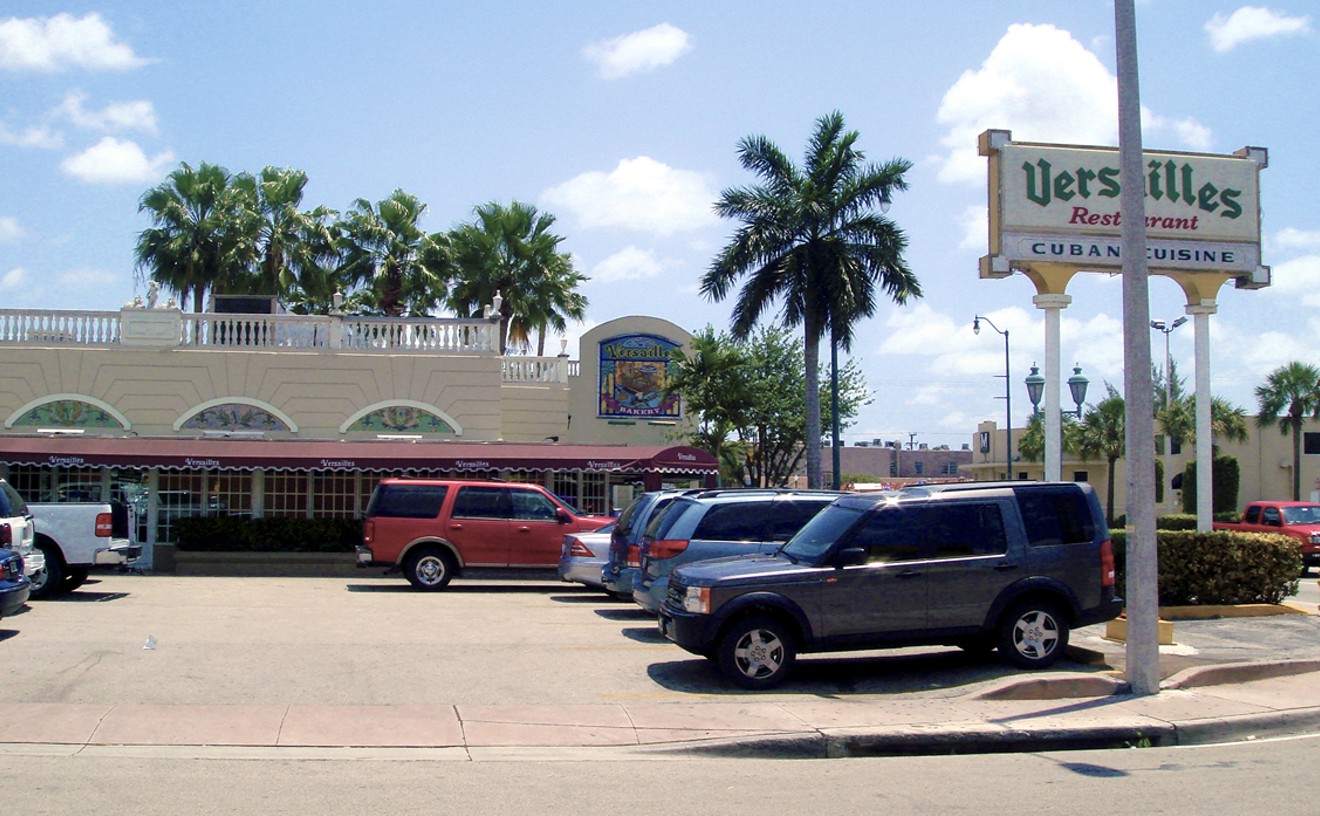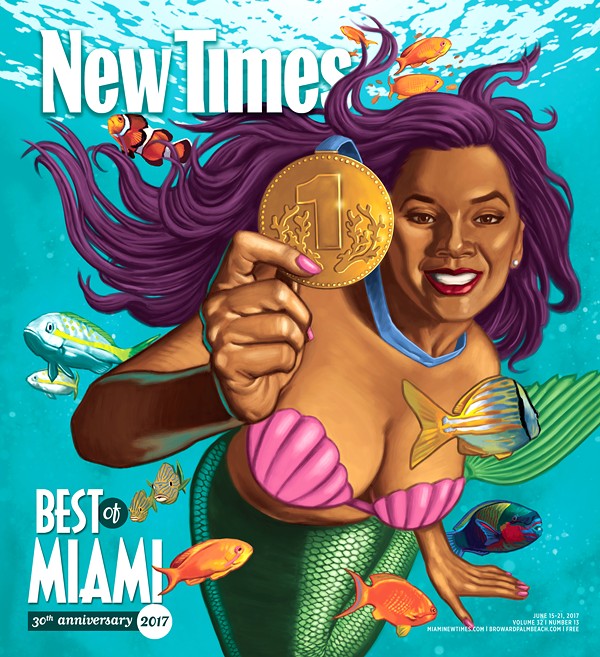When Fidel Castro died last year, only one spot in town drew dozens of sweat-drenched reporters, flag-waving exilios, and politicians clad in guayaberas: Versailles, the still-beating heart of Miami's Cuban diaspora. Presidential candidates can't win in this town without first sipping a cafecito at the restaurant's ventanita. The building remains a relic from Miami's 1980s heyday, when Cuban dissidents hung out inside and plotted ways to overthrow the Castro dictatorship. Nowadays, the eatery remains a family-friendly outpost for locals and tourists alike, where you can still down a plate of ropa vieja next to a city commissioner or just a few viejos talking trash about Che. When your out-of-town guests want a taste of the loco energy that makes the Magic City tick, a quick stop at Versailles is the only ticket you need.
Best Place to Take Out-of-Towners
Versailles
Best Festival
Borscht Film Festival

The Best Picture mixup at this year's Oscars might be the craziest thing to ever go down on the Academy Awards stage. But it didn't even rank among the weirdest things that happened in Miami's film scene this year, thanks to the Borscht Film Festival. For the tenth edition of its irregularly scheduled fest, the Borscht collective — a group of young filmmakers devoted to celebrating and sharing Miami's essential strangeness, and also responsible for introducing Moonlight's creators to each other — planned five days of hilarious and heartbreaking events and film screenings. They staged the festival's death, holding a funeral service at a Little Havana mortuary. They brought Animal Collective to the New World Center, a venue that normally hosts classical symphonies, to play trippy tunes accompanying videos of coral having sex. They rode Jet Skis across Biscayne Bay to a screening of the Kevin Costner anti-classic Waterworld. And if Borscht's events were inspired, the films the collective produced were inspiring. At the main screening, viewers saw a documentary about a dude who got internet-famous by filming videos of himself feeding deer in his backyard; a gritty neon drama about a violent Manila gang; and the short, animated tale of a Miami manicurist. One film showed artist Antonia Wright's naked body crashing through a glass pane in slow motion, over and over, more reverent, violent, and meaningful with each repetition. By the time the calendar hit Borscht's final day, which coincided with the Oscars, Moonlight's unorthodox win felt not only justified but also perfectly on trend.
Best Chutzpah
Miami-Dade County School Board
Warranted or not, there's sure a lot of talk about Soviet-era Communism filtering through the Zeitgeist. (Spasibo, Comrade Trump!) But Miami's jaw dropped in February when news broke that essentially boiled down to "state-run body tries to take control of public news-radio station." And, yes, that story took place right here in Miami-Dade County, not in Bishkek, Kyrgyzstan. Thanks to some wacky funding rules, the Miami-Dade County School Board technically owns the license to 91.3 WLRN, South Florida's essential National Public Radio affiliate. Apropos of nothing, the school board randomly decided it ought to have the power to hire and fire WLRN reporters and wanted to immediately force the station's 19 journalists to "reapply" for their jobs. Head-scratchingly, the board tried to claim the move was all about "safety," because WLRN reporters aren't subject to the same background-check requirements as other school board employees such as teachers or principals. This, of course, ignored the fact that the station had offered to match its rules to those of the school board, and shone a light on the real reason behind the move: A bald-faced power grab so obscene that the school board quickly had to retreat in the face of national outrage. Good call, because this isn't Soviet Russia, and a state body should never try to take over a news organization.
Best Public Restroom
The Design District

Rich or poor, beautiful or ugly, everyone has at least two things in common: We all, occasionally, need to go number one or number two. This can be a problem if, say, you find yourself in the middle of a shopping spree at Tom Ford on a muggy summer afternoon with only minutes until blastoff. If you so much as fart on one of those suits, they'll charge you a month's rent. Luckily, just up the escalator and to the right in Palm Court of Miami's luxe Design District lies the city's most glorious public bathrooms. Oh, they're something — spotless and sleek, with all the amenities you could hope for. The stalls offer privacy from floor to ceiling, eliminating that awkward eye-contact gap most mall bathrooms subject you to. Sweet soap and multiple drying options make cleanup a breeze.
- 140 NE 39th St., Miami, 33137 Map
- 305-722-7100
- miamidesigndistrict.net
Best Citizen
Dave Doebler
The best thing about living in Miami is the endless supply of things to do on the weekends. You can lounge on a pristine beach, dive amid neon-hued coral, blast through the Everglades in an airboat, and dance until sunrise at myriad world-class nightclubs. Dave Doebler took one look at the list of those selfish but glorious free-time options and thought, Actually, I would like to spend my Saturdays collecting trash. Doebler runs Volunteer Cleanup, a group that organizes trash pickup operations across Miami Beach. Doebler also chairs the city's Sustainability and Resiliency Committee and has worked to ban polystyrene products from polluting Biscayne Bay. Doebler knows South Florida is an environmental jewel — and unlike the thousands of visitors who vomit garbage on the beach every weekend, he sticks around to take care of it.
Best Power Couple
Ximena Caminos and Alan Faena
In a few short years, the stretch of Miami Beach from 32nd to 36th Street has gone from a rundown tourist trap to a glittering, world-class destination for the top 1 percent of the 1 percent. This is due to the vision of Alan Faena working with an incredible group of collaborators, including his longtime work partner, Ximena Caminos. The Argentine Faena is all id: He wears white exclusively, walks around in hats as large as oil rigs, and spends his free time building gigantic hotels and art houses with his name slapped on the side. He's like the most tasteful sibling Donald Trump never had. (Goldman Sachs CEO Lloyd Blankfein and art-world king Larry Gagosian have already bought property at the Faena House condos, so Faena's Rolodex isn't far off from the Donald's.) And Caminos, the executive director of the nonprofit Faena Art, is in charge of bringing the culture of the district to life by supporting artists through the commissioning of new and time-based exhibitions — from popular to experimental — that are open to the community. In November, Caminos told Vogue she's trying to use the District's spaces, such as the newly built Faena Forum on Indian Creek Drive, to create a "fantastic artists' movement, a new romanticism" in town. We'll take that over a faceless condo complex any day.
Best Local Boy Made Good
Tyrese Cooper
Seventeen-year-old Tyrese Cooper, easily one of the fastest teenagers in America and among the fastest people in the world, trains on a homemade dirt track in Miami Gardens. Raised in a cozy house in the throes of Liberty City, the tall and willowy high-school junior has broken nearly every national high-school track record in which he's competed. That's an especially rare feat because most competitive runners stick to a single race. High-school track meets, especially short-distance events, are typically neck-and-neck contests. But two years ago, Cooper caught everyone's attention when the no-name eighth-grader began leaving freshmen and sophomores at least ten meters behind him at the finish line. Now Cooper doesn’t run to win; he runs for time. In the 400-meter, his signature race, the shy teen clocks 45.23, which makes him one of the ten fastest people on Earth. In that event, Cooper is faster than Usain Bolt was at his age. Cooper will likely go pro at the end of the year, and he's a shoo-in to represent the United States at the World Championships in London this August. After that? Medals await at the Tokyo 2020 Olympics.
Best Local Boy Gone Bad
Reince Priebus

He looks so sincerely happy in the mid-'90s yearbook photos: shirtless and slathered in orange and green paint at an Orange Bowl tailgate, visiting lonely old folks at a retirement home, building a Habitat for Humanity house with his fellow University of Miami law school classmates. Reince Priebus was a brilliant, well-liked student during his three years in Coral Gables before graduating cum laude in 1998. He was elected president of the Student Bar Association, helped edit the Law Review, and even played shortstop on Oral Proposition, their cheekily named softball team. In other words, he's not the kind of kid you'd have expected to help usher fascism into America. Yet there he is today, ever-present in the shadow of Donald Trump. As White House chief of staff, he has overseen the xenophobic Muslim ban, stood behind the Russian-aided election hacking, and silently cheered the catastrophic Trumpcare plan. Where has our old, carefree Reince gone? Someone get Priebus some Canes face paint, stat.
Best Local Girl Made Good
Angelica Sweeting

As a child, Angelica Sweeting quickly noticed the dolls she played with didn't look much like her. Sure, some had darker skin like her own, but they also had straight hair, thin noses, and Caucasian features. Those dolls defined her standard of beauty and lowered her self-esteem. Years later, when her own 4-year-old daughter said she wished her hair was long, straight, and blond like Frozen's Elsa, Sweeting tried to find dolls with black features. When she couldn't, the University of Miami business school grad quit her job to solve the problem herself. That was almost three years ago. Since then, Sweeting has unveiled "Angelica": an 18-inch vinyl doll with fuller lips, a wider nose, and black tresses with kinks and curls. After successfully raising funds online and then selling more than 1,600 dolls in less than a year, Sweeting released three other dolls: Another black doll with a darker complexion, a Latina doll, and a biracial doll. In January, Sweeting appeared on Shark Tank, where Daymond John invested $200,000 in Naturally Perfect Dolls. Now she'll be able to mass-produce the dolls and make the toy store less homogenous for the next generation of children.
Best Local Girl Gone Bad
Liz Rios

In Greek mythology, sirens lured unwitting sailors to their deaths on rocky shores by taking the form of gorgeous women with enchanted voices. In Miami, where drunk partiers outnumber seafarers by a sizable margin, it only makes sense that our modern-day sirens prey on unsuspecting dance-floor navigators instead. That's exactly what police say 21-year-old Liz Rios did for months. On at least five occasions, police say, Rios met men at high-end clubs, took them home, drugged them, and then robbed them blind. Her haul allegedly included six figures' worth of Rolex watches, Louis Vuitton duffle bags, and jewelry. Fingerprints and surveillance footage brought this most Miami of crime sprees to an end. Rios faces three counts of felony grand theft.






